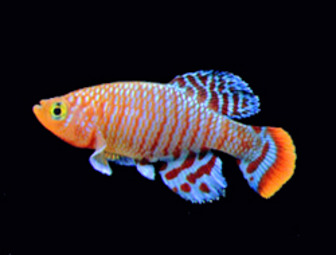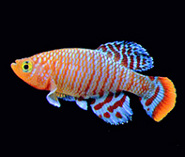Killifish

Original source: Andreas Wretström, isabulls isabulls.se Author Andreas Wretström, 2003. Resident in Uppsala, Sweden. Other versions 450 × 342 pix
Author: Andreas Wretström, 2003. Resident in Uppsala, Sweden. Other versions 450 × 342 pixels:
Permission: GNU Free Documentation License
The Killifish lives in the benthopelagic, non-migratory, freshwater environment.
Killifish - At Home in the Wild Or in the Aquarium
 Killifish, killiefish or banded pearlfish (Austrolebias adloffi) are commonly seen in the pet trade. Originally found in freshwater rivers and streams in Brazil and eastern Uruguay, they can now be found in aquariums throughout the world. Unlike many other species of freshwater fish, the killifish seems to thrive in captivity. Eggs are so tough that they can be mailed to would-be killifish fanciers. They are related to the Siamese fighting fish or Betta and have the same pugnacious attitude.
Killifish, killiefish or banded pearlfish (Austrolebias adloffi) are commonly seen in the pet trade. Originally found in freshwater rivers and streams in Brazil and eastern Uruguay, they can now be found in aquariums throughout the world. Unlike many other species of freshwater fish, the killifish seems to thrive in captivity. Eggs are so tough that they can be mailed to would-be killifish fanciers. They are related to the Siamese fighting fish or Betta and have the same pugnacious attitude.
Any fish, fish eating bird or reptile larger than a killifish can eat this little freshwater mouthful. Killifish eat insects, insect larvae and dead fish, including dead killifish. Pet killifish thrive on commercial foods, including flakes, freeze-dried and frozen fish foods. Wild fry at fist survive on a yolk sac and then begin eating zooplankton and microorganisms. Fry are particularly vulnerable to a larger species of killifish ' Megalebias prognathus.
General Description
Killifish bodies are shaped like common goldfish ' long fish with a small head, thick middle and tapers to a narrow tail. The long, narrow dorsal fin (fin at the top) contains 18 to 24 soft rays. The tail is triangular and only as wide as the fish’s belly. Adult killifish grow to an average 2 inches (5.08 cm) long. The largest fish recorded was a male measured at a whopping 4.6 inches (11.68 cm) long.
Males are more brightly colored and have pointier fins than females. Both sport neat dark blue and pale vertical stripes. The top and fins are blue and grey. The sides and belly of the fish vary from a pale pearl to yellow. There is often an emerald green spot behind the gills. A dark stripe goes through the eye, giving the eye a striped appearance. Males sport lighter, almost neon-blue fins and white spots in their fins and tail. Pet killifish have been bred to sport spots all over the body.
Life Cycle and Behavior
Killifish do not migrate and stay in the same stretch of water for all of their lives. After spawning, eggs are laid in heavily vegetated areas. The eggs are so tough that if there is a sudden drought, the eggs can survive up to 8 weeks on dry land. Killifish are not social fish and attack each other on sight. Males will attack females if the females are not in the mood to spawn. In captivity, killifish can spawn all year round.
On average, killifish only live for 8 months out in the wild, but can live between 3 and four years in captivity. Females tend to live longer than males, perhaps because they do not engage in so many battles over mates. Killifish have been known to live up to 3.7 years if kept in 68 degree F (20 degree C) water. Unfortunately, killifish need slightly warmer water in order to spawn.
Picture of the killifish by Andreas Wretström, 2003. Resident in Uppsala, Sweden, licensed under the Creative Commons Attribution-Share Alike 2.5 Generic license
Common names
Adloffs Fächerfisch in German (Deutsch)
Cinolebia in Spanish (español)
Gebänderter Fächerfisch in German (Deutsch)
Killifish in English
Raitaviuhkaevä in Finnish (suomen kieli)
Raitaviuhkapyrstö in Finnish (suomen kieli)
艾氏珠鮰 in Chinese (中文)
艾氏珠鮰 in Mandarin Chinese

Family : Rivulidae
Genus : Austrolebias
Species : Austrolebias adloffi
Authority : Ahl, 1922
